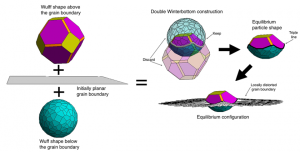
The open-source code, WulffMaker, is available as a Wolfram computable document format file or a Mathematica notebook.
Image: MIT/Rachel Zucker
Recent PhD recipient and past ECS student member, Rachel Zucker, examined one of the most complex issues in materials science and has developed a range of mathematical solutions to explain the phenomena known as “dewetting” in solid films. In defense of her thesis, Zucker modeled dewetting in microscale and nanoscale thin films.
Dewetting can be boiled down to the general break-up of material due to excess surface energy. Zucker’s development provides us with not only a new understanding of this phenomenon, but also a way to simulate it. When analyzing solid state dewetting, issues becomes very prominent as engineers attempt to make products with smaller and smaller features.
“The big takeaway is: One, we can write down formulation of this problem; two, we can implement a numerical method to construct the solutions; three, we can make a direct comparison to experiments; and that strikes me as what a thesis should be — the complete thing — formulation, solution, comparison, conclusion,” said W. Craig Carter, MIT professor and Zucker’s co-adviser.
Aside from her research at MIT, Zucker also spent a good majority of time working on her doctorate in Germany at the Max Planck Institute, where she joined other researchers who were attempting to develop a better understanding of solid state dewetting in order to control it and form specific patterns.
“I wanted to work on these surface-energy-driven problems because they are so fundamental to materials science,” Zucker explains.
This from MIT:
In a 2012 paper, Zucker presented a new method for finding the equilibrium shapes of faceted particles attached to a deformable surface. With Carter and three others, Zucker presented a suite of software tools to calculate these equilibrium shapes as well as for isolated particles and for particles attached to rigid interfaces. Their open-source code, WulffMaker, is available as a Wolfram computable document format file or a Mathematica notebook. It is useful for modeling Wulff shapes for engineering materials such as alumina, as well as more complicated Winterbottom and double Winterbottom shapes.
“This tool introduces a new computational method for finding shapes of minimal interface energy. It also helps to build intuition about the macroscopic properties of interfaces and their interactions, and aids in the quantitative measurement of interface energy densities, given a geometry. Properties such as the equivalent wetting angle, particle contact area, total energies, and distortions to the interface surrounding the particle are displayed by the software to enable further insight and analysis,” Zucker wrote in her thesis.
P.S. ECS’s Dirk Guldi is a world leader in the area of construction of nanostructured thin films for solar energy conversion. We recently sat down with him and other pillairs in fullerenes, nanocarbons, and thin films. Listen to what they have to say in our “A Word About Nanocarbons” podcast!

